Organic Transistors Based on Highly Crystalline Donor–Acceptor π-Conjugated Polymer of Pentathiophene and Diketopyrrolopyrrole
Abstract
1. Introduction
2. Results
2.1. Synthesis and Characterization of Material PDPP-5Th
2.2. Density Functional Theory (DFT) Calculation
2.3. Photophysical and Electrochemical Properties of PDPP-5Th
2.4. Conductive Properties of OFET Device
2.5. Thin-Film Surface Morphology
2.6. Molecular Stacking Characterization
3. Materials and Methods
4. Conclusions
Supplementary Materials
Author Contributions
Funding
Institutional Review Board Statement
Informed Consent Statement
Data Availability Statement
Acknowledgments
Conflicts of Interest
References
- Shen, T.; Li, W.; Zhao, Y.; Liu, Y.; Wang, Y. An all-C–H-activation strategy to rapidly synthesize high-mobility well-balanced ambipolar semiconducting polymers. Matter 2022, 5, 1953–1968. [Google Scholar] [CrossRef]
- Zhang, Y.; Wang, Y.; Gao, C.; Ni, Z.; Zhang, X.; Hu, W.; Dong, H. Recent advances in n-type and ambipolar organic semiconductors and their multi-functional applications. Chem. Soc. Rev. 2023, 52, 1331–1381. [Google Scholar] [CrossRef] [PubMed]
- Wu, F.; Liu, Y.; Zhang, J.; Duan, S.; Ji, D.; Yang, H. Recent Advances in High-Mobility and High-Stretchability Organic Field-Effect Transistors: From Materials, Devices to Applications. Small Methods 2021, 5, 2100676–2100701. [Google Scholar] [CrossRef] [PubMed]
- Wu, Y.; Zhao, Y.; Liu, Y. Toward Efficient Charge Transport of Polymer-Based Organic Field-Effect Transistors: Molecular Design, Processing, and Functional Utilization. Acc. Mater. Res. 2021, 2, 1047–1058. [Google Scholar] [CrossRef]
- Zhao, Y.; Guo, Y.; Liu, Y. 25th Anniversary Article: Recent Advances in n-Type and Ambipolar Organic Field-Effect Transistors. Adv. Mater. 2013, 25, 5372–5391. [Google Scholar] [CrossRef]
- Xu, Y.; Jia, Y.; Liu, P.; Jiang, Q.; Hu, D.; Ma, Y. Poly(3,4-ethylenedioxythiophene) (PEDOT) as promising thermoelectric materials and devices. Chem. Eng. J. 2021, 404, 126552–126567. [Google Scholar] [CrossRef]
- Chen, J.; Yang, J.; Guo, Y.; Liu, Y. Acceptor Modulation Strategies for Improving the Electron Transport in High-Performance Organic Field-Effect Transistors. Adv. Mater. 2021, 34, 2104325–2104355. [Google Scholar] [CrossRef]
- Shi, Y.; Li, W.; Wang, X.; Tu, L.; Li, M.; Zhao, Y.; Wang, Y.; Liu, Y. Isomeric Acceptor–Acceptor Polymers: Enabling Electron Transport with Strikingly Different Semiconducting Properties in n-Channel Organic Thin-Film Transistors. Chem. Mater. 2022, 34, 1403–1413. [Google Scholar] [CrossRef]
- Wang, Y.; Hasegawa, T.; Matsumoto, H.; Michinobu, T. Significant Difference in Semiconducting Properties of Isomeric All-Acceptor Polymers Synthesized via Direct Arylation Polycondensation. Angew. Chem. 2019, 58, 11893–11902. [Google Scholar] [CrossRef]
- Zhang, L.; Di, C.-A.; Yu, G.; Liu, Y. Solution processed organic field-effect transistors and their application in printed logic circuits. J. Mater. Chem. 2010, 20, 7059–7073. [Google Scholar] [CrossRef]
- Garnier, F.; Yassar, A.; Hajlaoui, R.; Horowitz, G.; Deloffre, F.; Servet, B.; Ries, S.; Alnot, P. Molecular engineering of organic semiconductors: Design of self-assembly properties in conjugated thiophene oligomers. J. Am. Chem. Soc. 1993, 115, 8716–8721. [Google Scholar] [CrossRef]
- Larik, F.A.; Faisal, M.; Saeed, A.; Abbas, Q.; Kazi, M.A.; Abbas, N.; Thebo, A.A.; Khan, D.M.; Channar, P.A. Thiophene-based molecular and polymeric semiconductors for organic field effect transistors and organic thin film transistors. J. Mater. Sci. Mater. Electron. 2018, 29, 17975–18010. [Google Scholar] [CrossRef]
- Nielsen, C.B.; McCulloch, I. Recent advances in transistor performance of polythiophenes. Prog. Polym. Sci. 2013, 38, 2053–2069. [Google Scholar] [CrossRef]
- Kaloni, T.P.; Giesbrecht, P.K.; Schreckenbach, G.; Freund, M.S. Polythiophene: From Fundamental Perspectives to Applications. Chem. Mater. 2017, 29, 10248–10283. [Google Scholar] [CrossRef]
- Allard, S.; Forster, M.; Souharce, B.; Thiem, H.; Scherf, U. Organic Semiconductors for Solution-Processable Field-Effect Transistors (OFETs). Angew. Chem. Int. Ed. 2008, 47, 4070–4098. [Google Scholar] [CrossRef]
- Spann, R.; Boucher, D. Impact of molecular weight on the solubility parameters of poly(3-hexylthiophene). J. Polym. Sci. 2022, 61, 503–514. [Google Scholar] [CrossRef]
- Chen, H.; Zhang, W.; Li, M.; He, G.; Guo, X. Interface Engineering in Organic Field-Effect Transistors: Principles, Applications, and Perspectives. Chem. Rev. 2020, 120, 2879–2949. [Google Scholar] [CrossRef] [PubMed]
- Gburek, B.; Wagner, V. Influence of the semiconductor thickness on the charge carrier mobility in P3HT organic field-effect transistors in top-gate architecture on flexible substrates. Org. Electron. 2010, 11, 814–819. [Google Scholar] [CrossRef]
- Opoku, H.; Lee, J.H.; Nketia-Yawson, B.; Bae, S.; Lee, J.-J.; Ahn, H.; Jo, J.W. Configurationally Random Polythiophene for Improved Polymer Ordering and Charge-Transporting Ability. ACS Appl. Mater. Interfaces 2020, 12, 40599–40606. [Google Scholar] [CrossRef]
- Park, J.W.; Lee, D.H.; Chung, D.S.; Kang, D.-M.; Kim, Y.-H.; Park, C.E.; Kwon, S.-K. Conformationally Twisted Semiconducting Polythiophene Derivatives with Alkylthiophene Side Chain: High Solubility and Air Stability. Macromolecules 2010, 43, 2118–2123. [Google Scholar] [CrossRef]
- Li, Y.; Sonar, P.; Murphy, L.; Hong, W. High mobility diketopyrrolopyrrole (DPP)-based organic semiconductor materials for organic thin film transistors and photovoltaics. Energy Environ. Sci. 2013, 6, 1684–1710. [Google Scholar] [CrossRef]
- Yang, Y.; Liu, Z.; Chen, J.; Cai, Z.; Wang, Z.; Chen, W.; Zhang, G.; Zhang, X.; Chi, L.; Zhang, D. A Facile Approach to Improve Interchain Packing Order and Charge Mobilities by Self-Assembly of Conjugated Polymers on Water. Adv. Sci. 2018, 5, 1801497–1801505. [Google Scholar] [CrossRef] [PubMed]
- Wang, Z.; Gao, M.; He, C.; Shi, W.; Deng, Y.; Han, Y.; Ye, L.; Geng, Y. Unraveling the Molar Mass Dependence of Shearing-Induced Aggregation Structure of a High-Mobility Polymer Semiconductor. Adv. Mater. 2022, 34, 2108255–2108263. [Google Scholar] [CrossRef] [PubMed]
- Guo, X.; Facchetti, A.; Marks, T.J. Imide- and Amide-Functionalized Polymer Semiconductors. Chem. Rev. 2014, 114, 8943–9021. [Google Scholar] [CrossRef] [PubMed]
- Hong, J.; Kim, J.; Li, Z.; Cong, C.; Rand, B.P.; Nam, S.Y.; Kim, S.H.; Kim, Y.H. Facile Direct Printing of DPP-Based Polymers for Organic Field-Effect Transistors and Logic Gates. ACS Appl. Electron. Mater. 2023, 5, 4114–4124. [Google Scholar] [CrossRef]
- Otep, S.; Lin, Y.-C.; Matsumoto, H.; Mori, T.; Wei, K.-H.; Michinobu, T. Diketopyrrolopyrrole–thiophene–methoxythiophene based random copolymers for organic field effect transistor applications. Org. Electron. 2020, 87, 105986. [Google Scholar] [CrossRef]
- Desu, M.M.; Sharma, S.; Cheng, K.-H.; Wang, Y.; Nagamatsu, S.; Chen, J.C.; Pandey, S.S. Controlling the Molecular Orientation of a Novel Diketopyrrolopyrrole-Based Organic Conjugated Polymer for Enhancing the Performance of Organic Field-Effect Transistors. SSRN Electron. J. 2022, 113, 106691–106700. [Google Scholar] [CrossRef]
- Lee, J.; Shin, E.-S.; Kim, Y.-J.; Noh, Y.Y.; Yang, C. Controlling the ambipolarity of thieno-benzo-isoindigo polymer-based transistors: The balance of face-on and edge-on populations. J. Mater. Chem. C 2020, 8, 296–302. [Google Scholar] [CrossRef]
- Ren, S.; Zhang, W.; Wang, Z.; Yassar, A.; Chen, J.; Zeng, M.; Yi, Z. Preparation of Dye Semiconductors via Coupling Polymerization Catalyzed by Two Catalysts and Application to Transistor. Molecules 2023, 29, 71–85. [Google Scholar] [CrossRef]
- Guo, X.; Ortiz, R.P.; Zheng, Y.; Hu, Y.; Noh, Y.Y.; Baeg, K.J.; Facchetti, A.F.; Marks, T.J. Bithiophene-imide-based polymeric semiconductors for field-effect transistors: Synthesis, structure-property correlations, charge carrier polarity, and device stability. J. Am. Chem. Soc. 2011, 133, 1405–1418. [Google Scholar] [CrossRef]
- Becke, A.D. Density-functional thermochemistry. III. The role of exact exchange. J. Chem. Phys. 1993, 98, 5648–5652. [Google Scholar] [CrossRef]
- Lee, C.; Yang, W.; Parr, R.G. Development of the Colle-Salvetti correlation-energy formula into a functional of the electron density. Phys. Rev. B Condens. Matter 1988, 37, 785–789. [Google Scholar] [CrossRef] [PubMed]
- Frisch, M.J.; Trucks, G.W.; Schlegel, H.B.; Scuseria, G.E.; Robb, M.A.; Cheeseman, J.R.; Scalmani, G.; Barone, V.; Petersson, G.A.; Nakatsuji, H.; et al. Gaussian 16 Rev. C.01; Gaussian, Inc.: Wallingford, CT, USA, 2016. [Google Scholar]
- Miehlich, B.; Savin, A.; Stoll, H.; Preuss, H. Results obtained with the correlation energy density functionals of becke and Lee, Yang and Parr. Chem. Phys. Lett. 1989, 157, 200–206. [Google Scholar] [CrossRef]
- Cho, Y.; Park, S.; Jeong, S.; Yang, H.; Lee, B.; Lee, S.M.; Lee, B.H.; Yang, C. Regioregular, yet ductile and amorphous indacenodithiophene-based polymers with high-mobility for stretchable plastic transistors. J. Mater. Chem. C 2021, 9, 9670–9682. [Google Scholar] [CrossRef]
- Liu, Y.; Hao, W.; Yao, H.; Li, S.; Wu, Y.; Zhu, J.; Jiang, L. Solution Adsorption Formation of a π-Conjugated Polymer/Graphene Composite for High-Performance Field-Effect Transistors. Adv. Mater. 2017, 30, 1705377–1705384. [Google Scholar] [CrossRef] [PubMed]
- Huang, K.; Huang, G.; Wang, X.; Lu, H.; Zhang, G.; Qiu, L. Air-Stable and High-Performance Unipolar n-Type Conjugated Semiconducting Polymers Prepared by “Strong Acceptor-Weak Donor” Strategy. ACS Appl. Mater. Interfaces 2020, 12, 17790–17798. [Google Scholar] [CrossRef]
- Lu, T.; Chen, F. Multiwfn: A multifunctional wavefunction analyzer. J. Comput. Chem. 2011, 33, 580–592. [Google Scholar] [CrossRef] [PubMed]
- Estrada, L.A.; Stalder, R.; Abboud, K.A.; Risko, C.M.; Brédas, J.L.; Reynolds, J.R. Understanding the Electronic Structure of Isoindigo in Conjugated Systems: A Combined Theoretical and Experimental Approach. Macromolecules 2013, 46, 8832–8844. [Google Scholar] [CrossRef]
- Che, Q.; Zhang, W.; Wei, X.; Zhou, Y.; Luo, H.; Wei, J.; Wang, L.; Yu, G. High-Mobility Ambipolar Benzodifurandione-Based Copolymers with Regular Donor-Acceptor Dyads Synthesized via Aldol Polycondensation. CCS Chem. 2023, 5, 2603–2616. [Google Scholar] [CrossRef]
- Kim, Y.; Long, D.X.; Lee, J.; Kim, G.; Shin, T.J.; Nam, K.-W.; Noh, Y.-Y.; Yang, C. A Balanced Face-on to Edge-on Texture Ratio in Naphthalene Diimide-Based Polymers with Hybrid Siloxane Chains Directs Highly Efficient Electron Transport. Macromolecules 2015, 48, 5179–5187. [Google Scholar] [CrossRef]
- Zhang, F.; Mohammadi, E.; Qu, G.; Dai, X.; Diao, Y. Orientation-Dependent Host–Dopant Interactions for Manipulating Charge Transport in Conjugated Polymers. Adv. Mater. 2020, 32, 2002823–2002830. [Google Scholar] [CrossRef] [PubMed]
- Park, Y.D.; Lee, S.G.; Lee, H.S.; Kwak, D.; Lee, D.H.; Cho, K. Solubility-driven polythiophene nanowires and their electrical characteristics. J. Mater. Chem. 2011, 21, 2338–2343. [Google Scholar] [CrossRef]
- Liu, Y.; Wang, F.; Chen, J.; Wang, X.; Lu, H.; Qiu, L.; Zhang, G. Improved Transistor Performance of Isoindigo-Based Conjugated Polymers by Chemically Blending Strongly Electron-Deficient Units with Low Content To Optimize Crystal Structure. Macromolecules 2018, 51, 370–378. [Google Scholar] [CrossRef]
- Ren, S.; Zhang, W.; Wang, Z.; Yassar, A.; Liao, Z.; Yi, Z. Synergistic Use of All-Acceptor Strategies for the Preparation of an Organic Semiconductor and the Realization of High Electron Transport Properties in Organic Field-Effect Transistors. Polymers 2023, 15, 3392–3404. [Google Scholar] [CrossRef] [PubMed]
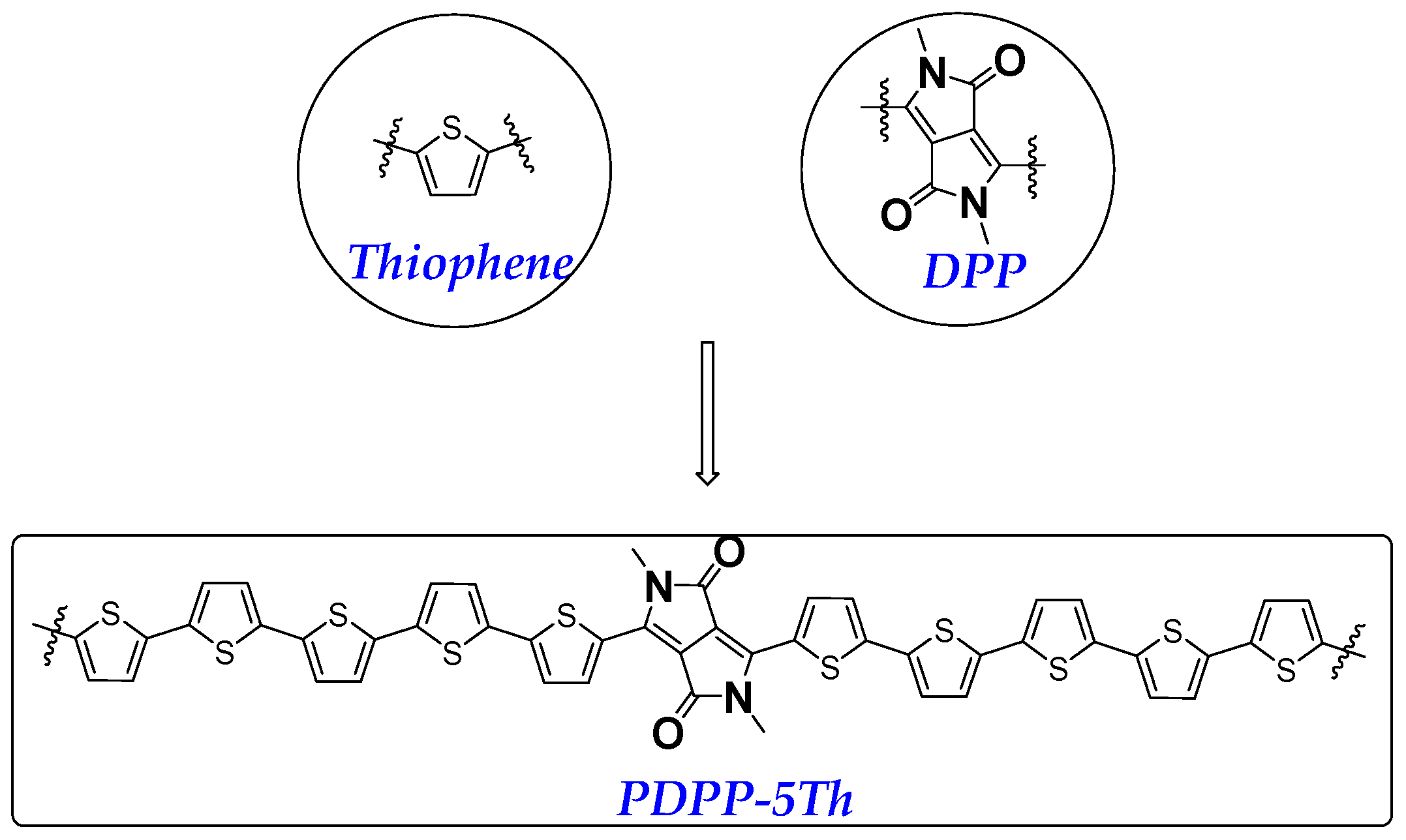

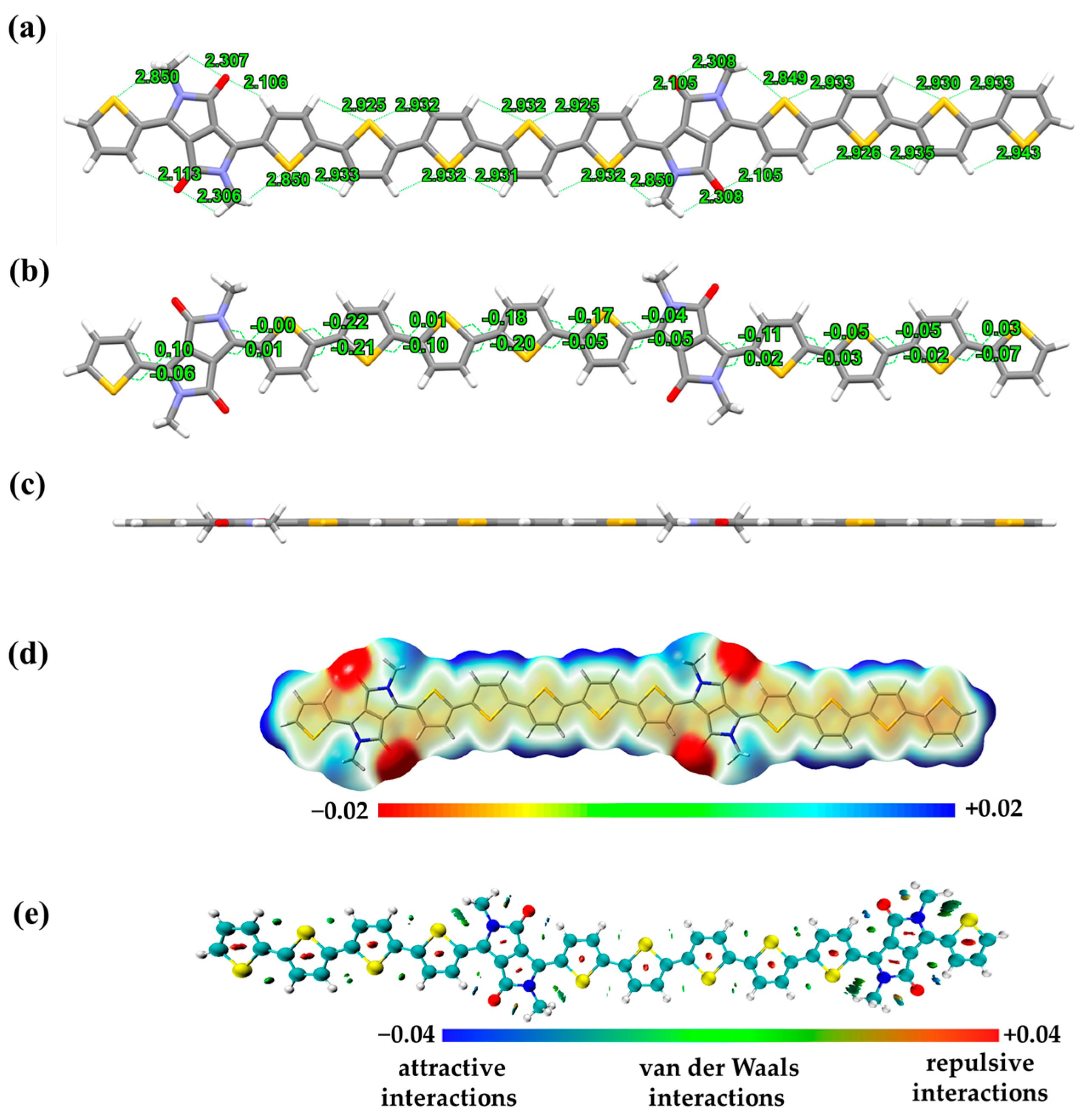
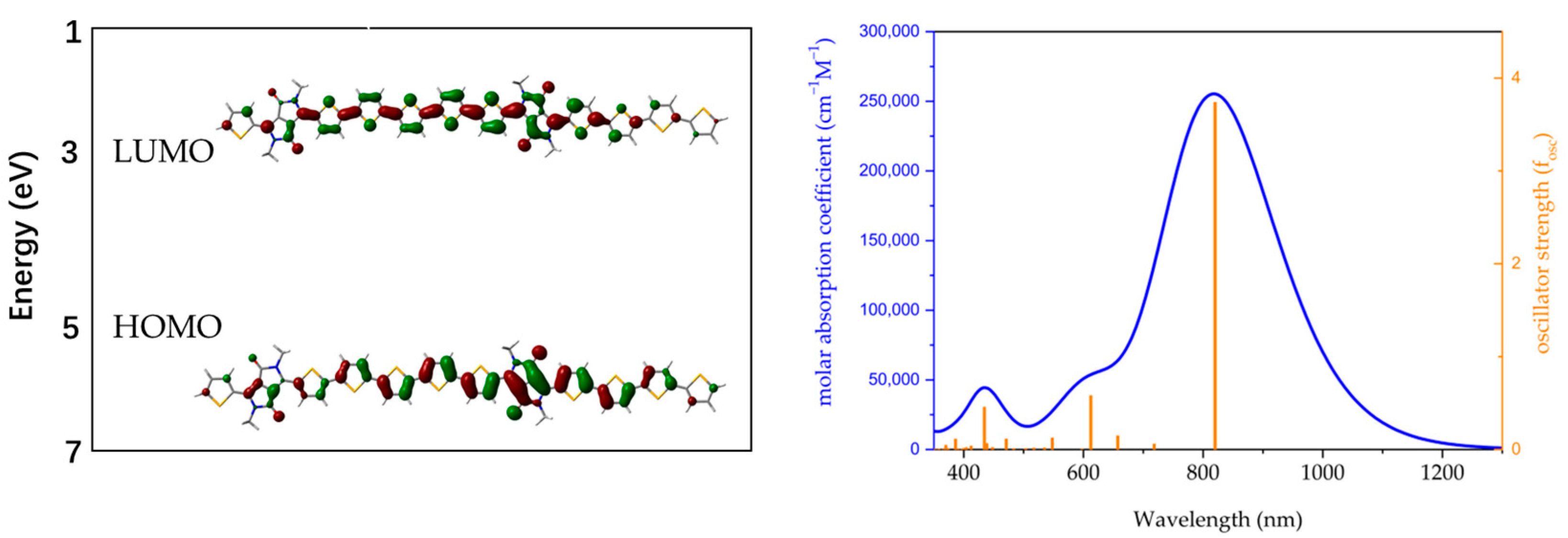

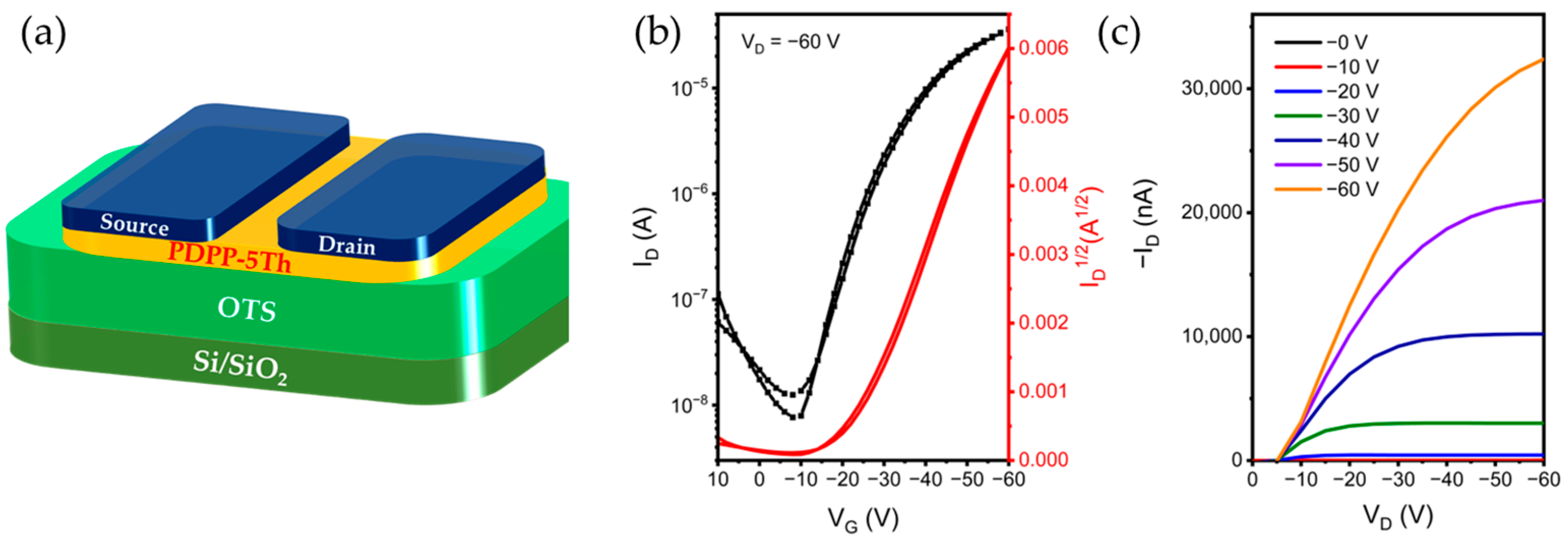

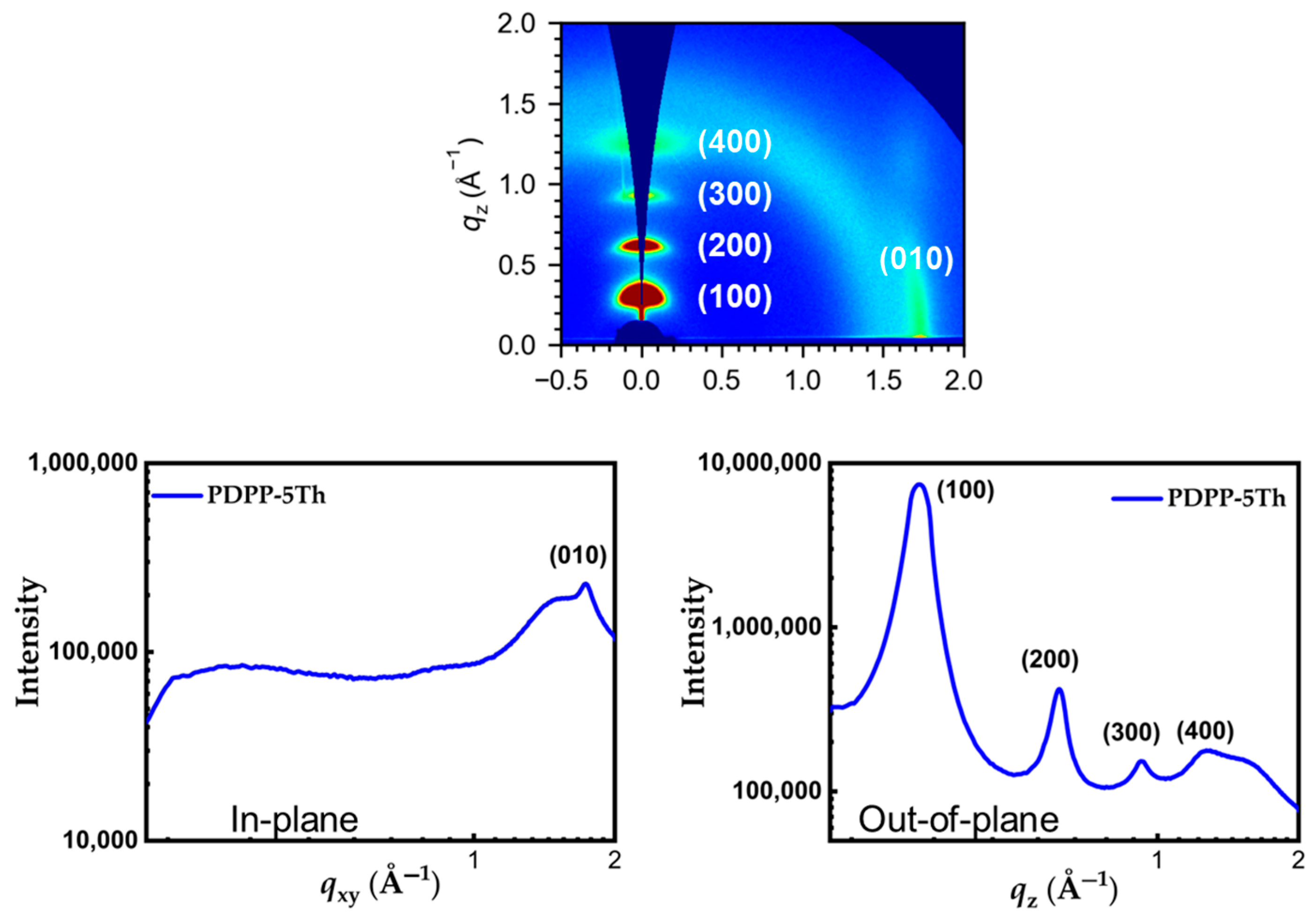
| Mn | Mw | PDI 1 | C 2 | H 2 | N 2 | |
|---|---|---|---|---|---|---|
| (Da) | (Da) | (%) | (%) | (%) | ||
| PDPP-5Th | 33,403 | 127,947 | 3.83 | 71.53 | 8.68 | 2.02 |
| Repeating unit | N/A | N/A | N/A | 72.85 | 9.09 | 2.30 |
| Coating Speed (rpm) | Annealing Temperature (°C) | Max Hole Mobilities (cm2 V−1 s−1) | Average Hole Mobilities 1 (cm2 V−1 s−1) | Threshold Voltage (V) | ION/IOFF |
|---|---|---|---|---|---|
| 2000 | 160 | 0.21 | 0.16 ± 0.04 | −23 | 103–104 |
| 2000 | 180 | 0.44 | 0.40 ± 0.03 | −19 | 103–104 |
| 2000 | 200 | 0.39 | 0.34 ± 0.02 | −26 | 103–104 |
| 2000 | 220 | 0.29 | 0.22 ± 0.05 | −29 | 103–104 |
| Material | In-Plane (010) Peak (Å−1) | π-Spacing (Å) 1 | Out-of-Plane (100) Peak (Å−1) | d-Spacing (Å) 1 |
|---|---|---|---|---|
| PDPP-5Th | 1.73 | 3.63 | 0.31 | 20.26 |
Disclaimer/Publisher’s Note: The statements, opinions and data contained in all publications are solely those of the individual author(s) and contributor(s) and not of MDPI and/or the editor(s). MDPI and/or the editor(s) disclaim responsibility for any injury to people or property resulting from any ideas, methods, instructions or products referred to in the content. |
© 2024 by the authors. Licensee MDPI, Basel, Switzerland. This article is an open access article distributed under the terms and conditions of the Creative Commons Attribution (CC BY) license (https://creativecommons.org/licenses/by/4.0/).
Share and Cite
Ren, S.; Wang, Z.; Chen, J.; Wang, S.; Yi, Z. Organic Transistors Based on Highly Crystalline Donor–Acceptor π-Conjugated Polymer of Pentathiophene and Diketopyrrolopyrrole. Molecules 2024, 29, 457. https://doi.org/10.3390/molecules29020457
Ren S, Wang Z, Chen J, Wang S, Yi Z. Organic Transistors Based on Highly Crystalline Donor–Acceptor π-Conjugated Polymer of Pentathiophene and Diketopyrrolopyrrole. Molecules. 2024; 29(2):457. https://doi.org/10.3390/molecules29020457
Chicago/Turabian StyleRen, Shiwei, Zhuoer Wang, Jinyang Chen, Sichun Wang, and Zhengran Yi. 2024. "Organic Transistors Based on Highly Crystalline Donor–Acceptor π-Conjugated Polymer of Pentathiophene and Diketopyrrolopyrrole" Molecules 29, no. 2: 457. https://doi.org/10.3390/molecules29020457
APA StyleRen, S., Wang, Z., Chen, J., Wang, S., & Yi, Z. (2024). Organic Transistors Based on Highly Crystalline Donor–Acceptor π-Conjugated Polymer of Pentathiophene and Diketopyrrolopyrrole. Molecules, 29(2), 457. https://doi.org/10.3390/molecules29020457







